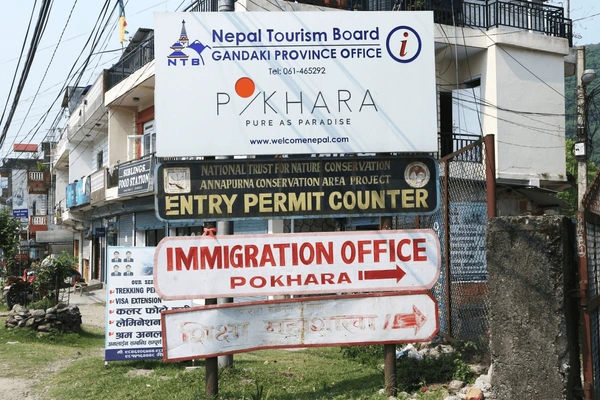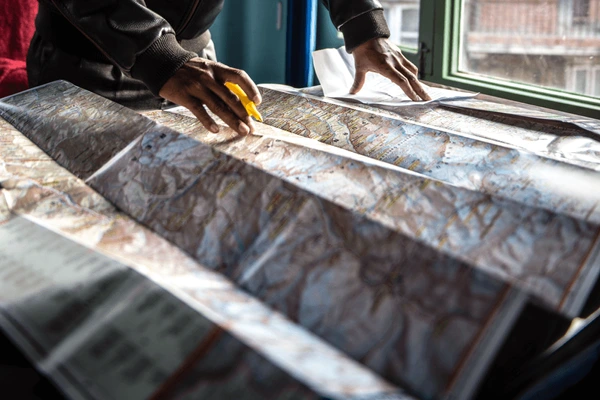Trekking Permits
for Annapurna Base Camp Trek
The Annapurna circuit is a trekking route in Nepal popular for its diverse natural landscapes and beautiful trekking routes. The beautiful Annapurna base camp weather makes the trip more memorable. The trek route contains natural landscapes and beautiful forests offering the trekkers a unique and beautiful blend of the nature and native traditions. If you want to enjoy that visit, then you should have some of the permits. These permits are mandatory for the trekkers to complete the circuit as it helps to support tourism in the area and also ensures the safety of the trekkers and environment. Obtaining the permit is important not only for the trekkers but also for the safety concerns of the environment. These permits help the authorities to manage the resources accordingly and track visitor’s activities.
If you are planning to climb the Annapurna Circuit, then it is important to have the Annapurna Circuit Trekking Permit which will allow you to enter the areas which are protected and areas which are inaccessible without the Annapurna Circuit Permit.
Overview of Annapurna Circuit Permits

Trekking the Annapurna Circuit is an adventure of a lifetime that requires passion for hiking and also the careful preparation, including the requirement of the necessary permits. Permits are required in the Annapurna region for the assistance of local community development, maintain safety standards, and to uphold the environment. They help manage the number of trekkers within the Annapurna Conservation Area, keep an eye on their locations for their security purposes, and to support conservation efforts. If you want to start this beautiful and well known trek, you just need to secure specific permissions, which may be acquired at certain offices in Pokhara or Kathmandu. The total Annapurna base camp trek cost of these permits differs depending on your nationality and also changes according to the residents of different countries. Here is an overview of all the information you need to obtain the Annapurna base camp trek permits.
What is the Annapurna Circuit Trekking Permit?
The Annapurna Circuit Permit is the mandatory certification that allows hikers to access and navigate the Annapurna Conservation Area. There will be an approval which is required to protect the fragile natural balance of the area and to guarantee that hikers follow selected routes and also follow the certain safety measures. Regardless of whether you want to take the entire Annapurna Circuit or a shorter path, you must obtain this authorization in order to enter the Annapurna region. In addition to making the trip legal, it raises funds for social and environmental initiatives, which supports the region’s sustainable growth.
Different Types of Annapurna Circuit Trekking Permits
The Trekkers Information Management System (TIMS) card and the Annapurna Conservation Area Permit (ACAP) are the two permits needed to complete the circuit.
Annapurna Conservation Area Permit (ACAP)
An Annapurna Conservation Area Permit, or ACAP, is required for all trekkers to enter the area. A wide range of habitats, including endangered plants and animals, high-altitude forests, and cultural heritage sites, can be found inside the Annapurna Conservation Area (ACA). Ensuring a safer environment and supporting local communities is the goal of this permit for Annapurna conservation area.
Trekkers Information Management System (TIMS)
Every hiker must have a Trekkers Information Management System tims card. This Annapurna Circuit Permit is intended to oversee trekking trails, ensure a safer atmosphere, and regulate trekkers in various locations
Cost of Annapurna Circuit Permits
The cost of Annapurna Circuit Permits is given below:
TIMS CARD
- For non-SAARC trekker the charges are NPR 2,000 / USD $17.
- For SAARC trekker the charges are NPR 1,000 / USD $7.50.
ACAP Permit
- For foreigners the charges are USD $30.
- For SAARC nationals: Approximately USD $5.
No fee for the locals (Nepali citizens).
How to Obtain an Annapurna Circuit Permit?

The TIMS Card and ACAP Permit may be obtained at specialized offices or trekking firms, regardless of your starting point in Kathmandu or Pokhara. Here’s a detailed view:
Step by Step Guide for Obtaining Annapurna Circuit Permits
Visit the Permit Office: To apply for your permits, visit the office that is closest to you in either Pokhara or Kathmandu.
Complete the paperwork: You should prepare the copies of all required documents like passport, passport sized pictures, and information of traveller insurance.
Applying procedure: After you have completed the paperwork you then need to fill out the applications of ACAP Permit and TIMS Card in person at the office.
Complete and Pay: After applying you need to submit your papers and then you need to pay the fee in Nepalese rupees (NPR). You must have the cash in hand as they usually take payments in cash.
Receive Your Permits: After they check your documents and payment, you will get your TIMS Card and ACAP Permit right there! Keep these permits with you while trekking. They will check them at different spots along the trail.
Permit Offices in Kathmandu and Pokhara
Here’s where you can go to get your permits for the Annapurna Circuit trekking:
Kathmandu:
Nepal Tourism Board Office
Location: Bhrikutimandap, Kathmandu
Trekking Agencies Association of Nepal TAAN:
Location: Maligaon, Kathmandu
Pokhara:
Nepal Tourism Board Office:
Location: Damside, Pokhara
ACAP Permit Office (Annapurna Conservation Area Project):
Location: Lakeside, Pokhara
You can also get permits through registered trekking agencies. Just know that there might be an extra fee for this service.
Required Documents for Permits

To get your Annapurna Circuit permits, keep these documents handy:
Passport Copies: At least two copies of your passport (the personal info page).
Passport Sized Photos: You will need two photos for the TIMS Card.
Details of Travel Insurance: Although not necessary for permits, having travel insurance that covers hiking at high altitudes is an excellent idea. Certain agencies could request this information.
Contact Information: When applying for a TIMS Card, you will need to provide the name of an emergency contact as well as specifics about your hiking itinerary.
Following these instructions and having the necessary paperwork ready will guarantee that you obtain the permissions you need for an enjoyable and risk-free walk across the Annapurna Circuit.
Detailed Breakdown of the Annapurna Circuit Trek Permit Costs

Are you planning to trek the Annapurna Circuit? Do not worry, we got you covered. First of all, remember that It is really important to know about the different Annapurna circuit permit costs. These expenses can affect your budget for the adventure. The fees vary depending on who you are and from which part of the world you belong.
Let us explain one by one the permit costs for foreign visitors, Nepali citizens, and Indian citizens.
Cost for Foreign Nationals
If you are a foreign trekker, you will be needing two types of permits. The first one is Annapurna Conservation Area Permit (ACAP) and the second one is Trekkers Information Management System (TIMS) Card. The prices for these permits are mentioned below:
ACAP Permit
For foreign nationals from non-SAARC countries, it’s around USD $30 (about NPR 3,000).
For Indian nationals, as they are part of SAARC countries, it costs just USD $50 (around NPR 500).
TIMS Card
If you are trekking alone, a TIMS Card will cost USD $20 (NPR 2,000).
But if you are trekking in a group with a registered trekking agency, it is only USD $10 (NPR 1,000).
So, if you’re a foreign national trekking solo, your total permit fees (ACAP and TIMS) would be about USD $50. For Indian nationals trekking alone, the total would be around USD $25; for those in a group, it’s about USD $15.
Permit Costs for Nepali Citizens
Nepali citizens have some great advantages when it comes to trekking costs in Annapurna! They don’t have to pay for the ACAP permit as it is totally free for them.
TIMS Card
Group trekkers pay around USD $6 (NPR 600). Solo trekkers may not even need a TIMS card if they know the area well or are with a local guide. These means Nepali citizens can really lower their overall trekking costs compared to foreign trekkers.
Additional Costs: TIMS Card and Conservation Fees
Besides the ACAP permit, all trekkers need a TIMS Card. This card is important because it helps with safety monitoring and even rescue operations if needed. Here’s more info on these extra costs:
TIMS Card
Individual trekkers: USD $20 (NPR 2,000).
Group trekkers: USD $10 (NPR 1,000).
Permit Types for Additional Treks in the Annapurna Region
There are certain licenses like as the TIMS Card and ACAP are must for the Annapurna Circuit. There are some especial permissions are also required for other hikes in this area, such the Annapurna Base Camp trek. For anybody interested in visiting this beautiful region of Nepal, it is vital that they should be aware of these essentials.
Annapurna Base Camp Treks Permit
For ABC trek Nepal, you may need a special permit. Here’s what you got to know about getting the Annapurna Base Camp permit and Annapurna base camp trek permit cost:
ACAP Permit:
Just like on the Annapurna Circuit, trekkers need an Annapurna circuit trek permit to enter the Annapurna Conservation Area. It costs the same as for the circuit like USD $30 for foreign peoples and the Annapurna base camp trek permit cost for Indian is around USD $5.
TIMS Card:
You also got to get a TIMS Card, just like on the Annapurna Circuit. The fee is USD $20 you are going solo and USD $10 if you’re with a group.
Annapurna Base Camp Permit Cost:
Total for Foreign Nationals: Around $50 (ACAP + TIMS).
Total for Indian Nationals: About USD $25 (for solo treks) or USD $15 (if you’re in a group).
This total cost shows that getting Annapurna base camp trek permit cost for the Annapurna Base Camp trek is different for different nationals.
Special Permits for Restricted Areas

Some area of the Annapurna region trek needs extra permits, especially if they go into restricted areas. Places like Nar Phu Valley and Upper Mustang have special rules to keep their culture and nature safe. Here’s what to keep in mind:
Nar Phu Valley Trek:
You need a Special Permit along with the ACAP to go here. The Special Permit costs about USD $100 per person for the first 10 days and then an extra USD $10 for each day after that.
Trekkers usually have to be in a group and often need a local guide or have to join a trekking agency in Nepal to explore this area.
Upper Mustang Trek:
Going to Upper Mustang also requires a Special Permit, which is around USD $500 per person for 10 days, plus USD $50 for each extra day. This big fee helps cover its rich cultural background and sensitive ecosystem.
Like Nar Phu Valley, trekkers must also be in a group and usually need a local guide.
Differences from Annapurna Circuit Trekking Permits
Here are the main differences between the Annapurna Circuit trekking permit and those required for restricted spots like Nar Phu Valley and Upper Mustang:
Cost: Special permits for these restricted areas cost much more than standard ACAP and TIMS fees.
Regulations: Trekkers require guides to enter restricted regions in Nepal, and there are frequently restrictions on the number of persons who may go in a group. However, you are able to hike alone both the Annapurna region base camp trip and the Annapurna Circuit.
Cultural Significance: Stricter permission requirements are necessary because restricted places typically have distinct cultural values and regulations that support the preservation of local customs and ecosystems.
Role of Trekking Agencies in Getting Your Permits
Getting permits for trekking in Nepal can feel super tricky. But don’t worry! Trekking agencies are here to help. These agencies are backed by the Agencies Association of Nepal, are experts in handling all the complicated stuff so you can focus on the scenic routes ahead.
Overcoming Trekking Permit Challenges
You are all set for the Annapurna Circuit, ready to hike? Trekking agencies in Nepal take care of everything. They will get your TIMS card and even help with passport photos. They have what you need, and they do it fast!
Benefits of Trekking Agency
These agencies don’t just handle your forms. They are there for you as a safety guide. They will give important contacts in case of emergencies. So whether you’re on busy trails or way out in the quiet spots, you will always be able to reach someone who cares about your well-being. By working with a trekking agency, you cut out all the headaches of getting permits and turn the whole experience around.
Do you need a guide for the Annapurna Circuit?
Having a good guide is important for the safety purpose. Guides are available in Pokhara or Kathmandu and costs around 40 to 50 Usd.
Regulations and Rules for Trekking Permits
To make the attempts and treks in the Annapurna region required within certain limits, many action measures have been undertaken by the Nepal Tourism Board. There is also additional cooperation available from the government as police have to be provided with relevant Annapurna circuit permits and TIMS card, and these have to be contained throughout the entire trek at all these specific checkpoints.
Rules Regarding Permit Use
While the hiking individuals attempt to break the laws by foolishly refusing to provide reasonable explanations, they must show the files on every occasion asked in the restricted regions and inside the designed zones. They are placed there because they are meant to monitor how the trekkers behave and, therefore, ensure the safety of those people. Failure to obtain these permits before going on any such trek would result in the offender being penalized even with serious fines.
Consequences of Trekking Without a Permit
It is illegal and a punishable offense to undertake a trek in Nepal’s Annapurna without permits. Any individual who does so risks being fined, deported, or barred from trekking within the boundaries of Nepal. This restriction has been imposed to prevent polluting the area while simultaneously raising awareness among mountain climbers to do their share and conserve this area.
Do not forget to always be well equipped mentally and practically before even attributing this magnificent excitement of an adventure, and lastly, always keep your permits throughout the journey.
Conclusion
To trek the Annapurna Circuit, you need to get some permits first. The main ones are the Annapurna Conservation Area Permit (ACAP) and the Trekking Information Management System (TIMS) Card. These help keep the area safe and protect the environment. It’s best to get these permits ahead of time. Always carry emergency contact info, and let your folks know your route for added safety.
For more info, trekkers can check out resources from the Nepal Tourism Board (NTB), the Trekking Agencies’ Association of Nepal (TAAN), and the Annapurna Conservation Area Project (ACAP).
Getting your permits sorted ahead of time not only makes your trek start off smoothly but also supports responsible tourism in the beautiful Annapurna region.
